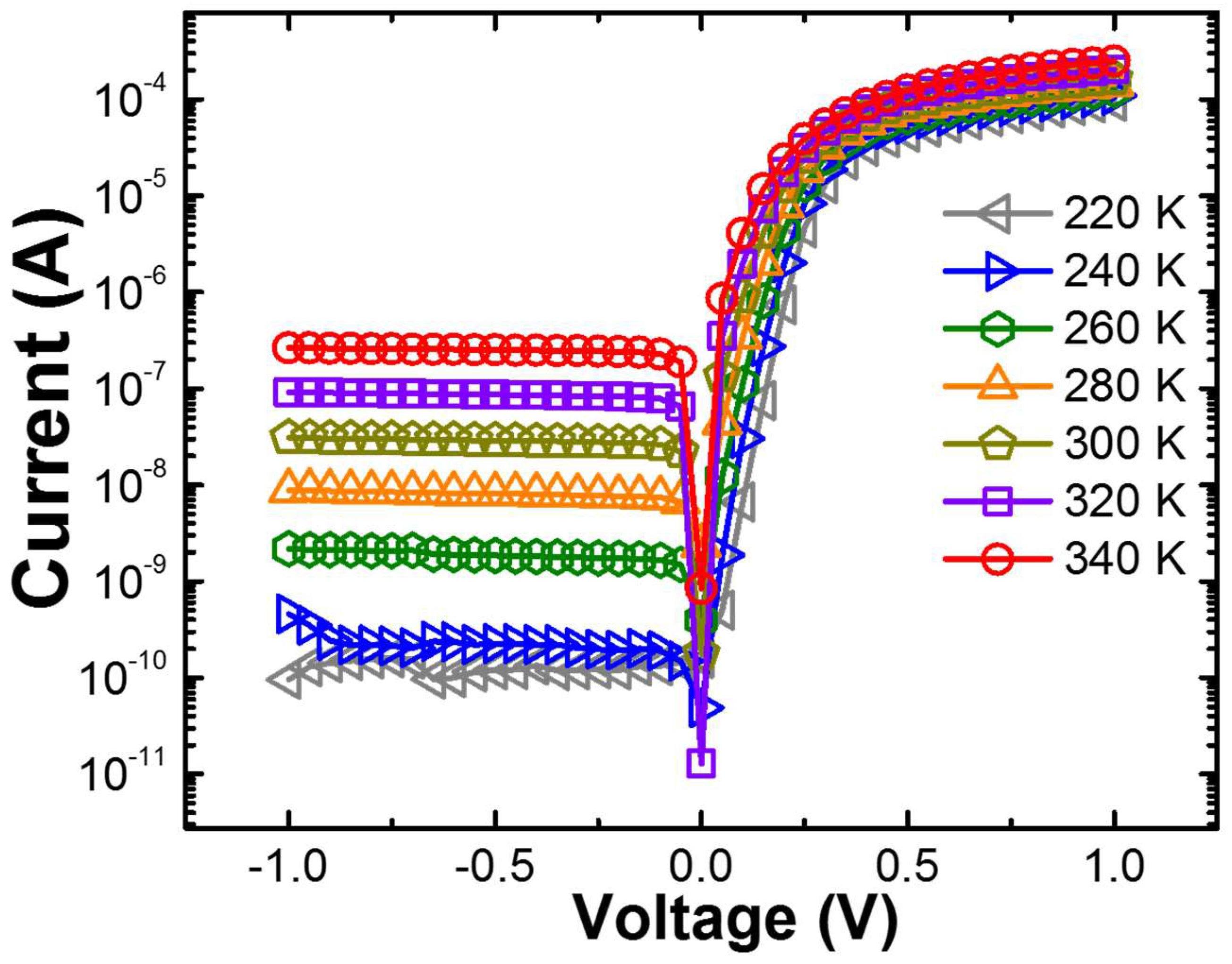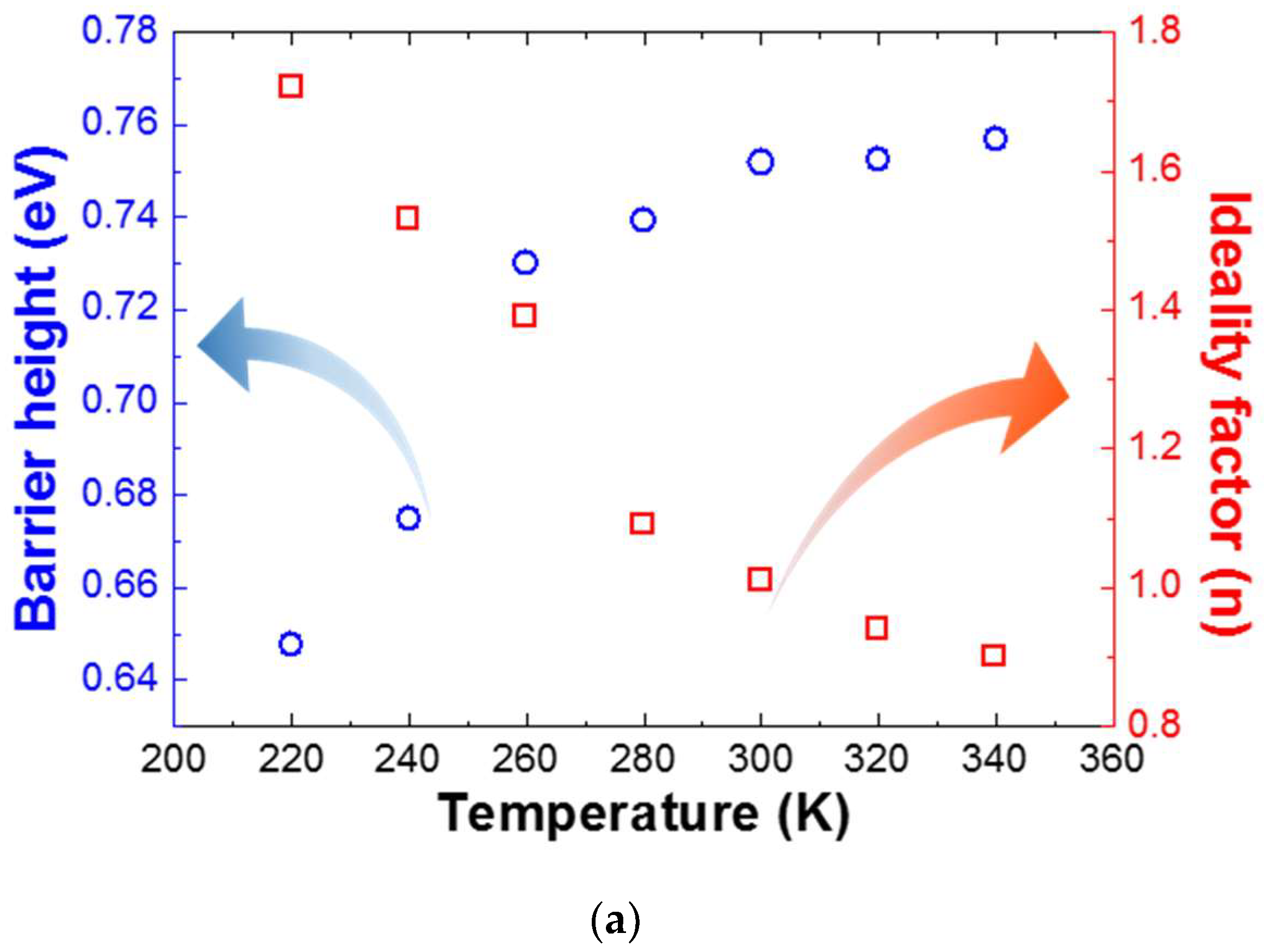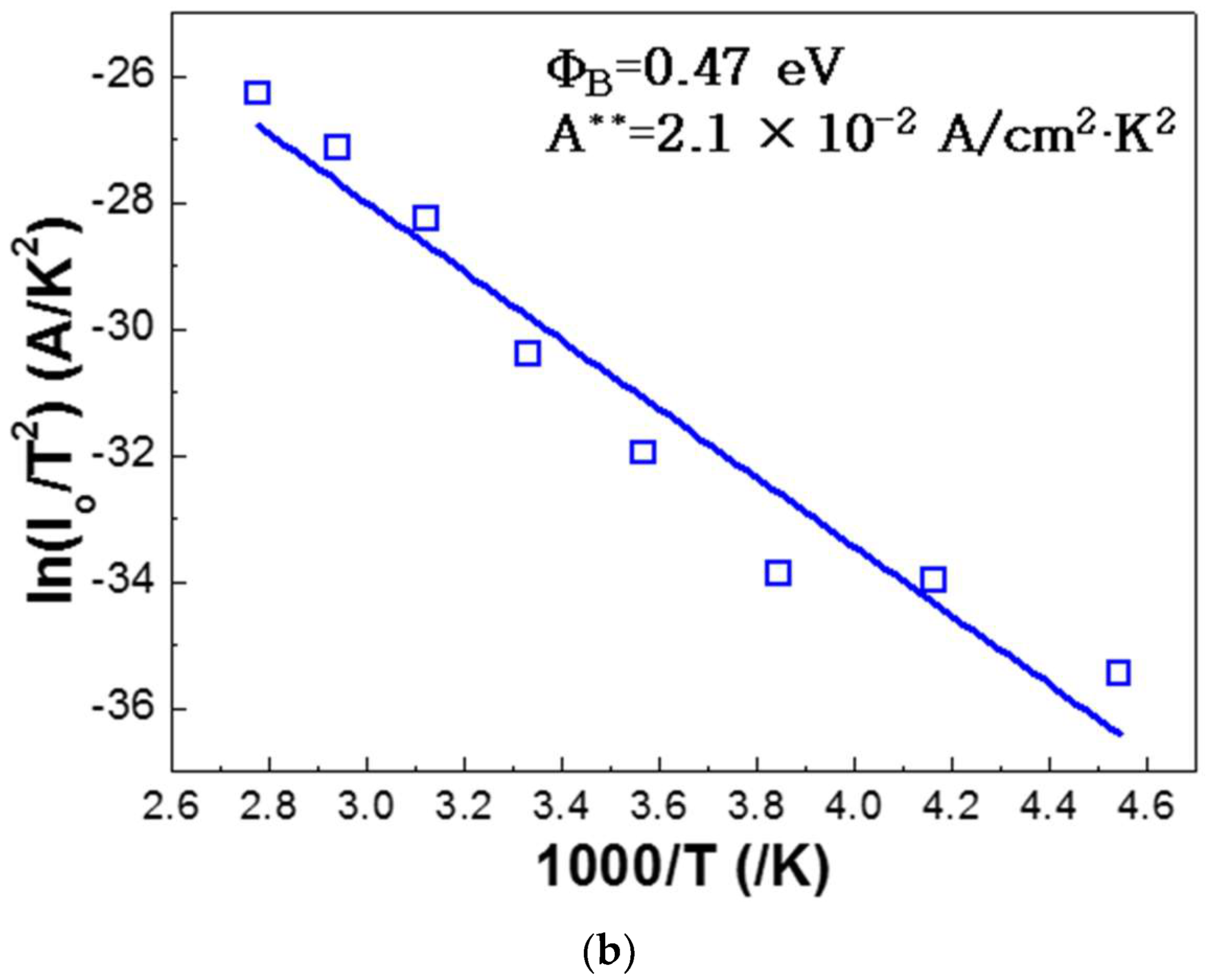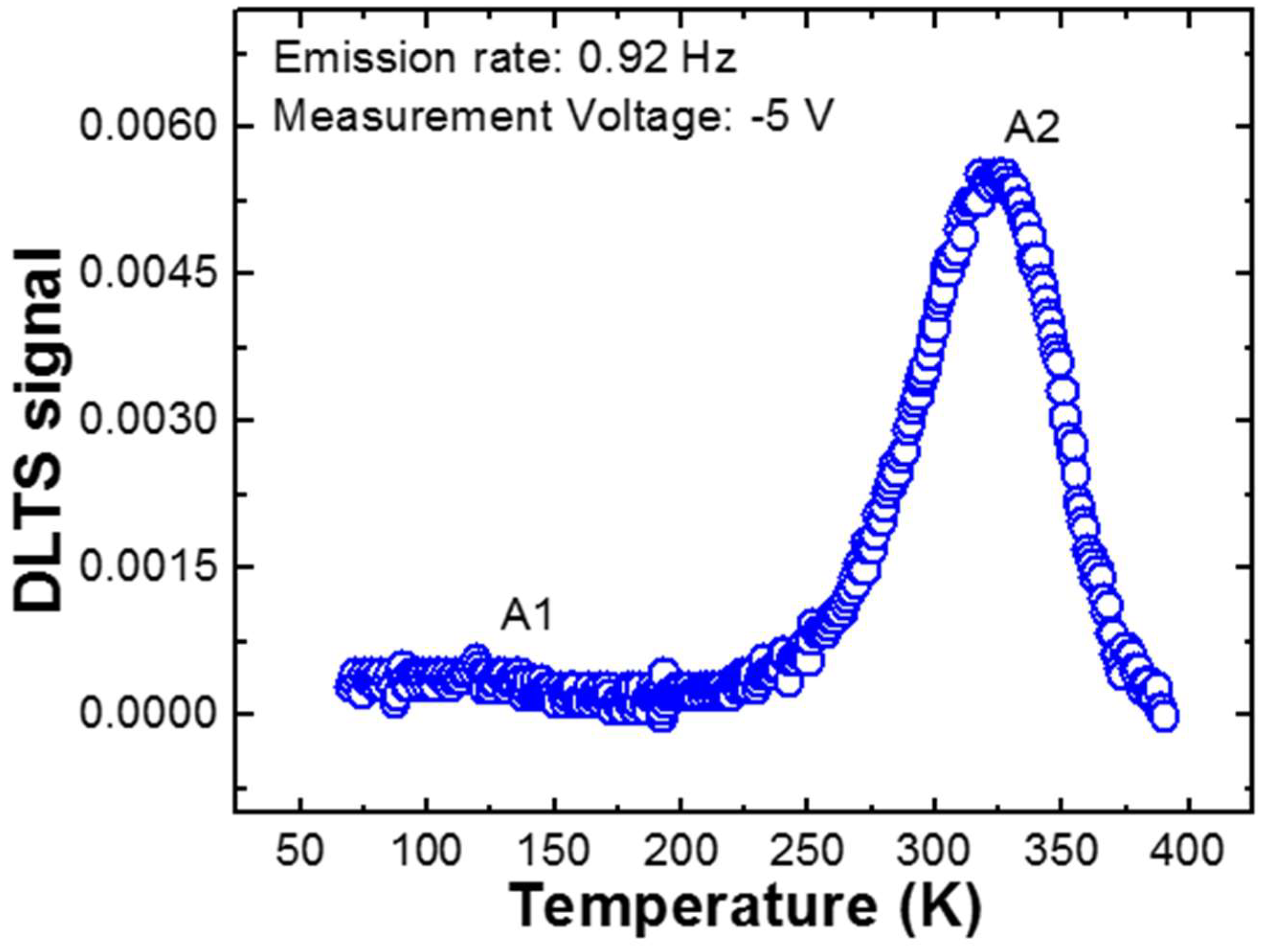Electronic Transport Mechanism for Schottky Diodes Formed by Au/HVPE a-Plane GaN Templates Grown via In Situ GaN Nanodot Formation
Abstract
1. Introduction
2. Materials and Methods
3. Results and Discussion
4. Conclusions
Supplementary Materials
Author Contributions
Funding
Acknowledgments
Conflicts of Interest
References
- Tang, F.; Zhu, T.; Oehler, F.; Fu, W.Y.; Griffiths, J.T.; Massabuau, F.C.-P.; Kappers, M.J.; Martin, T.L.; Bagot, P.A.; Moody, M.P. Indium clustering in a-plane InGaN quantum wells as evidenced by atom probe tomography. Appl. Phys. Lett. 2015, 106, 072104. [Google Scholar] [CrossRef]
- Jang, S.; Jung, S.; Park, J.; Kim, S.; Baik, K.H. Terahertz dielectric response of nonpolar a-plane GaN films. ECS Trans. 2017, 77, 127–131. [Google Scholar] [CrossRef]
- Sugiyama, T.; Honda, Y.; Yamaguchi, M.; Amano, H.; Isobe, Y.; Iwaya, M.; Takeuchi, T.; Kamiyama, S.; Akasaki, I.; Imade, M. Small current collapse in AlGaN/GaN HFETs on a-plane GaN self-standing substrate. Phys. Status Solidi (c) 2012, 9, 875–878. [Google Scholar] [CrossRef]
- Isobe, Y.; Ikki, H.; Sakakibara, T.; Iwaya, M.; Takeuchi, T.; Kamiyama, S.; Akasaki, I.; Sugiyama, T.; Amano, H.; Imade, M. Nonpolar a-plane AlGaN/GaN heterostructure field-effect transistors grown on freestanding GaN substrate. Appl. Phys. Express 2011, 4, 064102. [Google Scholar] [CrossRef]
- Matocha, K.; Tilak, V.; Dunne, G. Comparison of metal-oxide-semiconductor capacitors on c-and m-plane gallium nitride. Appl. Phys. lett. 2007, 90, 123511. [Google Scholar] [CrossRef]
- Wang, Y.-L.; Ren, F.; Lim, W.; Pearton, S.; Baik, K.H.; Hwang, S.-M.; Seo, Y.G.; Jang, S. Hydrogen sensing characteristics of non-polar a-plane GaN schottky diodes. Curr. Appl. Phys. 2010, 10, 1029–1032. [Google Scholar] [CrossRef]
- Rudziński, M.; Kudrawiec, R.; Patriarche, G.; Kucharski, R.; Caban, P.; Strupiński, W. Simultaneous growth of GaN/AlGaN quantum wells on c-, a-, m-, and (20.1)-plane GaN bulk substrates obtained by the ammonothermal method: Structural studies. J. Cryst. Growth 2015, 414, 87–93. [Google Scholar] [CrossRef]
- Zhang, J.; Tian, W.; Wu, F.; Wan, Q.; Wang, Z.; Zhang, J.; Li, Y.; Dai, J.; Fang, Y.; Wu, Z. The effects of substrate nitridation on the growth of nonpolar a-plane GaN on r-plane sapphire by metalorganic chemical vapor deposition. Appl. Surf. Sci. 2014, 307, 525–532. [Google Scholar] [CrossRef]
- Ryu, S.R.; Ram, S.G.; Kwon, Y.H.; Yang, W.C.; Kim, S.H.; Woo, Y.D.; Shin, S.H.; Kang, T.W. HVPE growth of self-aligned gan nanorods on c-plane, a-plane, r-plane, and m-plane sapphire wafers. J. Mater. Sci. 2015, 50, 6260–6267. [Google Scholar] [CrossRef]
- Moldawer, A.; Bhattacharyya, A.; Zhou, L.; Smith, D.J.; Moustakas, T.D. Characterization of a-plane GaN templates grown by hvpe and high efficiency deep uv emitting AlGaN/AlN MQWs grown by MBE on such templates. Phys. Status Solidi (c) 2014, 11, 585–589. [Google Scholar] [CrossRef]
- Lee, M.; Mikulik, D.; Yang, M.; Park, S. Nearly perfect GaN crystal via pit-assisted growth by HVPE. CrystEngComm 2017, 19, 2036–2041. [Google Scholar] [CrossRef]
- Amilusik, M.; Sochacki, T.; Lucznik, B.; Fijalkowski, M.; Iwinska, M.; Weyher, J.; Grzanka, E.; Krupczynska, P.; Khachapuridze, A.; Grzegory, I. Homoepitaxial HVPE GaN growth on non-and semi-polar seeds. J. Cryst. Growth 2015, 403, 48–54. [Google Scholar] [CrossRef]
- Kong, B.H.; Sun, Q.; Han, J.; Lee, I.-H.; Cho, H.K. Classification of stacking faults and dislocations observed in nonpolar a-plane GaN epilayers using transmission electron microscopy. Appl. Surf. Sci. 2012, 258, 2522–2528. [Google Scholar] [CrossRef]
- Paskova, T.; Kroeger, R.; Paskov, P.; Figge, S.; Hommel, D.; Monemar, B.; Haskell, B.; Fini, P.; Speck, J.; Nakamura, S. Microscopic emission properties of nonpolar α-plane GaN grown by HVPE. In Gallium Nitride Materials and Devices; International Society for Optics and Photonics: Bellingham, WA, USA, 2006; p. 612106. [Google Scholar]
- Wu, Y.-H.; Lee, C.-H.; Chu, C.-M.; Yeh, Y.-H.; Chen, C.-L.; Lee, W.-I. A simple growth method to produce a-plane GaN thick films by hydride vapor phase epitaxy. Jpn. J. Appl. Phys. 2013, 52, 08JB08. [Google Scholar] [CrossRef]
- Lee, M.; Mikulik, D.; Park, S. Thick GaN growth via gan nanodot formation by HVPE. CrystEngComm 2017, 19, 930–935. [Google Scholar] [CrossRef]
- Phark, S.-H.; Kim, H.; Song, K.M.; Kang, P.G.; Shin, H.S.; Kim, D.-W. Current transport in Pt schottky contacts to a-plane n-type GaN. J. Phys. D Appl. Phys. 2010, 43, 165102. [Google Scholar] [CrossRef]
- Kim, H.; Lee, S.-N.; Park, Y.; Kwak, J.S.; Seong, T.-Y. Metallization contacts to nonpolar a-plane n-type GaN. Appl. Phys. Lett. 2008, 93, 032105. [Google Scholar] [CrossRef]
- Schwartzkopf, M.; Buffet, A.; Körstgens, V.; Metwalli, E.; Schlage, K.; Benecke, G.; Perlich, J.; Rawolle, M.; Rothkirch, A.; Heidmann, B. From atoms to layers: In situ gold cluster growth kinetics during sputter deposition. Nanoscale 2013, 5, 5053–5062. [Google Scholar] [CrossRef] [PubMed]
- Imer, B.M.; Wu, F.; DenBaars, S.P.; Speck, J.S. Improved quality (11 2¯ 0) a-plane GaN with sidewall lateral epitaxial overgrowth. Appl. Phys. Lett. 2006, 88, 061908. [Google Scholar] [CrossRef]
- Moram, M.; Johnston, C.; Kappers, M.; Humphreys, C. Measuring dislocation densities in nonpolar a-plane GaN films using atomic force microscopy. J. Phys. D Appl. Phys. 2010, 43, 055303. [Google Scholar] [CrossRef]
- Taşçıoğlu, İ.; Aydemir, U.; Altındal, Ş.; Kınacı, B.; Özçelik, S. Analysis of the forward and reverse bias iv characteristics on Au/PVA: Zn/n-Si schottky barrier diodes in the wide temperature range. J. Appl. Phys. 2011, 109, 054502. [Google Scholar] [CrossRef]
- Kumar, A.; Arafin, S.; Amann, M.C.; Singh, R. Temperature dependence of electrical characteristics of Pt/GaN schottky diode fabricated by UHV e-beam evaporation. Nanoscale Res. Lett. 2013, 8, 481. [Google Scholar] [CrossRef] [PubMed]
- Peta, K.R.; Kim, M.D. Leakage current transport mechanism under reverse bias in Au/Ni/GaN schottky barrier diode. Superlattices Microstruct. 2017, 113, 678–683. [Google Scholar] [CrossRef]
- Iucolano, F.; Roccaforte, F.; Giannazzo, F.; Raineri, V. Barrier inhomogeneity and electrical properties of Pt/GaN schottky contacts. J. Appl. Phys. 2007, 102, 113701. [Google Scholar] [CrossRef]
- Rajpalke, M.K.; Bhat, T.N.; Roul, B.; Kumar, M.; Krupanidhi, S. Current transport in nonpolar a-plane InN/GaN heterostructures schottky junction. J. Appl. Phys. 2012, 112, 023706. [Google Scholar] [CrossRef]
- Song, Y.; Van Meirhaeghe, R.; Laflere, W.; Cardon, F. On the difference in apparent barrier height as obtained from capacitance-voltage and current-voltage-temperature measurements on Al/p-InP schottky barriers. Solid-State Electron. 1986, 29, 633–638. [Google Scholar] [CrossRef]
- Kwietniewski, N.; Sochacki, M.; Szmidt, J.; Guziewicz, M.; Kaminska, E.; Piotrowska, A. Influence of surface cleaning effects on properties of schottky diodes on 4H–SiC. Appl. Surf. Sci. 2008, 254, 8106–8110. [Google Scholar] [CrossRef]
- Kim, H.; Phark, S.H.; Song, K.M.; Kim, D.W. Electrical characterization of pt schottky contacts to a-plane n-type GaN. In AIP Conference Proceedings; AIP: Melville, NY, USA, 2011; pp. 923–924. [Google Scholar]
- Yu, L.; Liu, Q.; Xing, Q.; Qiao, D.; Lau, S.; Redwing, J. The role of the tunneling component in the current–voltage characteristics of metal-GaN schottky diodes. J. Appl. Phys. 1998, 84, 2099–2104. [Google Scholar] [CrossRef]
- Jang, J.-S.; Kim, D.; Seong, T.-Y. Schottky barrier characteristics of Pt contacts to n-type InGaN. J. Appl. Phys. 2006, 99, 073704. [Google Scholar] [CrossRef]
- Zhi, T.; Tao, T.; Liu, B.; Li, Y.; Zhuang, Z.; Zhang, G.; Xie, Z.; Zhang, R.; Zheng, Y. Asymmetric tunneling model of forward leakage current in GaN/InGaN light emitting diodes. AIP Adv. 2015, 5, 087151. [Google Scholar] [CrossRef]
- Sze, S. Physics of Semiconductors Devices; John Wiley & Son: Hoboken, NJ, USA, 2006. [Google Scholar]
- Faraz, S.; Willander, M.; Wahab, Q. Interface state density distribution in Au/n-ZnO nanorods schottky diodes. In IOP Conference Series: Materials Science and Engineering; IOP Publishing: Bristol, UK, 2012; p. 012006. [Google Scholar]
- Padovani, F.; Stratton, R. Field and thermionic-field emission in schottky barriers. Solid-State Electron. 1966, 9, 695–707. [Google Scholar] [CrossRef]
- Hacke, P.; Detchprohm, T.; Hiramatsu, K.; Sawaki, N. Schottky barrier on n-type GaN grown by hydride vapor phase epitaxy. Appl. Phys. Lett. 1993, 63, 2676–2678. [Google Scholar] [CrossRef]
- Miller, E.; Yu, E.; Waltereit, P.; Speck, J. Analysis of reverse-bias leakage current mechanisms in GaN grown by molecular-beam epitaxy. Appl. Phys. Lett. 2004, 84, 535–537. [Google Scholar] [CrossRef]
- Diale, M.; Auret, F.D. Effects of chemical treatment on barrier height and ideality factors of Au/GaN schottky diodes. Phys. B Condens. Matter 2009, 404, 4415–4418. [Google Scholar] [CrossRef]
- Janardhanam, V.; Jyothi, I.; Lee, J.-H.; Kim, J.-Y.; Reddy, V.R.; Choi, C.-J. Electrical properties and carrier transport mechanism of Au/n-GaN schottky contact modified using a copper pthalocyanine (CuPc) interlayer. Mater. Trans. 2014, 55, 758–762. [Google Scholar] [CrossRef]
- Garg, M.; Kumar, A.; Nagarajan, S.; Sopanen, M.; Singh, R. Investigation of significantly high barrier height in Cu/GaN schottky diode. AIP Adv. 2016, 6, 015206. [Google Scholar] [CrossRef]
- Fang, Z.-Q.; Look, D.C.; Jasinski, J.; Benamara, M.; Liliental-Weber, Z.; Molnar, R.J. Evolution of deep centers in GaN grown by hydride vapor phase epitaxy. Appl. Phys. Lett. 2001, 78, 332–334. [Google Scholar] [CrossRef]
- Takahashi, K.; Yoshikawa, A.; Sandhu, A. Wide Bandgap Semiconductors; Springer: Berlin/Heidelberg, Germany, 2007; p. 239. [Google Scholar]
- Cho, H.; Kim, C.; Hong, C.-H. Electron capture behaviors of deep level traps in unintentionally doped and intentionally doped n-type GaN. J. Appl. Phys. 2003, 94, 1485–1489. [Google Scholar] [CrossRef]
- Look, D.C.; Fang, Z.-Q.; Claflin, B. Identification of donors, acceptors, and traps in bulk-like HVPE GaN. J. Cryst. Growth 2005, 281, 143–150. [Google Scholar] [CrossRef]
- Armstrong, A.; Arehart, A.; Green, D.; Mishra, U.; Speck, J.; Ringel, S. Impact of deep levels on the electrical conductivity and luminescence of gallium nitride codoped with carbon and silicon. J. Appl. Phys. 2005, 98, 053704. [Google Scholar] [CrossRef]
- Pak, S.W.; Lee, D.U.; Kim, E.K.; Park, S.H.; Joo, K.; Yoon, E. Defect states of a-plane GaN grown on r-plane sapphire by controlled integration of silica nano-spheres. J. Cryst. Growth 2013, 370, 78–81. [Google Scholar] [CrossRef]
- Song, H.; Kim, E.K.; Baik, K.H.; Hwang, S.-M.; Jang, Y.W.; Lee, J.Y. Characterization of deep levels in a-plane GaN epi-layers grown using various growth techniques. J. Cryst. Growth 2012, 340, 23–27. [Google Scholar] [CrossRef]





| Ref. | Defect | Activation Energy (eV) | Capture Cross Section (cm2) | Trap Density (cm−3) |
|---|---|---|---|---|
| This study | A1 | 0.20 | 1.14 × 10−17 | 5 × 1012 |
| A2 | 0.55 | 4.4 × 10−17 | 4.7 × 1013 | |
| [42] | E1 | 0.23 | 5.43 × 10−15 | 9.5 × 1013 |
| E2 | 0.5 | 4.65 × 10−17 | 2.3 × 1014 | |
| [45] | EA1 | 0.56 | 9.72 × 10−16 | 3 × 1013 |
| [46] | E3 | 0.58 | 8.9 × 10−12 | 3.8 × 1014 |
© 2018 by the authors. Licensee MDPI, Basel, Switzerland. This article is an open access article distributed under the terms and conditions of the Creative Commons Attribution (CC BY) license (http://creativecommons.org/licenses/by/4.0/).
Share and Cite
Lee, M.; Vu, T.K.O.; Lee, K.S.; Kim, E.K.; Park, S. Electronic Transport Mechanism for Schottky Diodes Formed by Au/HVPE a-Plane GaN Templates Grown via In Situ GaN Nanodot Formation. Nanomaterials 2018, 8, 397. https://doi.org/10.3390/nano8060397
Lee M, Vu TKO, Lee KS, Kim EK, Park S. Electronic Transport Mechanism for Schottky Diodes Formed by Au/HVPE a-Plane GaN Templates Grown via In Situ GaN Nanodot Formation. Nanomaterials. 2018; 8(6):397. https://doi.org/10.3390/nano8060397
Chicago/Turabian StyleLee, Moonsang, Thi Kim Oanh Vu, Kyoung Su Lee, Eun Kyu Kim, and Sungsoo Park. 2018. "Electronic Transport Mechanism for Schottky Diodes Formed by Au/HVPE a-Plane GaN Templates Grown via In Situ GaN Nanodot Formation" Nanomaterials 8, no. 6: 397. https://doi.org/10.3390/nano8060397
APA StyleLee, M., Vu, T. K. O., Lee, K. S., Kim, E. K., & Park, S. (2018). Electronic Transport Mechanism for Schottky Diodes Formed by Au/HVPE a-Plane GaN Templates Grown via In Situ GaN Nanodot Formation. Nanomaterials, 8(6), 397. https://doi.org/10.3390/nano8060397







